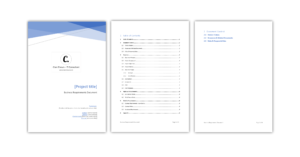
System Design Tip 2 – Linking related behaviour
Why it’s important to link related system behaviour
When designing any system or application, as a Solution Designer or Business Analyst, it is important to think through the longevity of your decisions. There are three main things to consider when trying to solve immediate change requests or enhancements. I’ve listed them in order of importance.
-
- Will this change affect existing parts of the system?
This is important because you don’t want to fix one issue and create another. - How easy is this change to maintain in future release cycles?
Understanding this will help with overall system maintenance, something that is often overlooked when trying to get a project over a deadline. Are you simply pushing problems into the future, by trying to get quick wins? - Will someone else understand this design, is it logical?
Someone is bound to come across your design in a future release, if its not well documented, it will be a nightmare to maintain or change. This is equally important for testers and help desk staff (level 1 and 2). Will other people be able to debug and find the root cause of an incident if your logic is convoluted?
- Will this change affect existing parts of the system?
To help remedy all three of these issues, it is important to group related behaviour to one piece of decision logic.
Real life example
Say for example you are designing a user interface for customer to submit an application form. When the customer enters their date of birth the system does the following:
-
- A message pops-up telling them why they need to provide this information,
- A new screen appears in the process flow, asking for country of origin details, and
- On submission the customer needs to upload a copy of their birth certificate.
Here is what a solution designer should and should not do when designing this system.
Do this.
All three of the above features are linked, they are related to the customer’s date of birth. It is best practice to ensure all three related outcomes are linked to one piece of decision logic. Meaning the popup message, the new screen and the required documentation should all be linked to a piece of code/logic, something like the following:
IF
date.of.birth in database is not null
THEN
display pop-up message AND
add new screen to process flow AND
add the required document to the submission screen.
END
The above logic basically says if a valid date of birth exists in the database, then trigger the 3 system actions (message, new screen and required documentation). The logic infers the date of birth is in a valid format, because validation should be applied before it is saved to the database.
Don’t do this.
Here is what a Solution Designer should not do. They should not create three independent triggers for each system behaviour related to the customer’s data of birth.
-
- A message pops-up giving them a warning.
Triggered by: UI screen element, on-click on date of birth field. - A new screen appears in the process flow, asking for country of origin details.
Triggered by: Database element, if date of birth exists in database, display new screen. - On submission they need to upload a copy of their birth certificate.
Triggered by: Process flow, if the new country of origin screen exists.
- A message pops-up giving them a warning.
Why take this design approach?
There are a few reasons it is important to link related system behaviour to one piece of controlling logic.
- Simplicity
Harder to design, but easier to build and maintain. It will be harder to design the system this way. Especially if different teams are responsible for aspects of the same system. It will take some negotiating to get a consensus on design. But in the long run it will be worth it. It will be easier to build for the developer, as they will only need one piece of logic to link the behaviours too. - Future proofing
There will most likely come a time when a new Analyst or Developer will need to change a part of your design. If you have not linked related features, most likely one will get changed and not the others. If not identified in testing or UAT, it will cause production issues. Which could result in loss of business or loss of revenue.
My tips
When designing applications, strongly consider linking related system behaviour to one piece of decision logic. Here are my summarised system design tips for this kind of situation.
-
- Simplicity
Assign related system behaviour to one piece of decision logic. - Accessibility
Use an indicator that is accessible system wide. For example, a value in a database. - Visionary
Future proof, think about how easy your design will be to maintain in future releases.
- Simplicity
Related articles
- March 1, 2020Software Design
- January 8, 2020Software Design
- November 1, 2019Software Design


